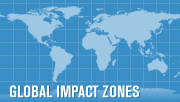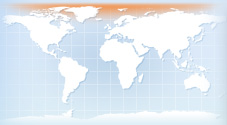Melting Arctic Circle Ice Drives Polar Bears Closer to Extinction

The Arctic is the hot-seat of global warming, with rapidly melting ice a threat to polar bears, native Arctic culture, and even the world’s coastal population living in warmer climates.
While elevated concentrations of greenhouse gases are warming the Arctic as in other regions on Earth, the Arctic is warming at a faster rate. This amplified response is thought to be due in large part to the melting of Arctic ice. Ice acts like a mirror to the sun’s energy, reflecting much of it back out into space. As Arctic ice disappears, dark ocean water and land is revealed, which soaks up more sunlight and accelerates warming and melting. Other drivers of accelerated climate change in the Arctic are related to the circulation patterns and heat exchanged in the ocean and atmosphere.
Many climatic changes have already been documented in the Arctic. By the decade of the 2000s, for example, much of the Arctic warmed by 1 to 2 degrees Celsius (1.8 – 3.6 degrees Fahrenheit) compared to the period from 1951 to 1980, a level of warming that exceeded most other regions on Earth.
As temperatures rise in the Arctic, sea ice and glaciers are melting at a staggering rate. The Arctic ice extents in the last four years (2007 to 2010) have been the four lowest on record. In 2010, the extent of ice in the Arctic was the third-lowest recorded since observations began in 1979 and the area of missing ice compared to the baseline from 1979 to 2000 was nearly five times the size of California. The amount of thicker, multi-year ice has also been in decline.
In addition to the loss of ice extent in recent decades, the thickness of ice in the Arctic has also been in decline. From submarine measurements, researchers have observed an average loss of nearly 6 feet of Arctic ice between 1980 and 2008, almost half of the average ice thickness.
Current trends suggest that Arctic summers will ultimately become ice free. Arctic sea ice in September, the month of minimum ice extent, is now declining by more than 11 percent per decade relative to the 1979 – 2000 baseline period. Leading Arctic models predict that Arctic summer sea ice may completely disappear within the next 30 years and possibly as early as the late 2020s.
The ice covering Arctic land is also melting and contributing to global sea level rise. Most of the ice in the Arctic is found in the Greenland ice sheet. A recent study showed that around 385 cubic miles of this ice sheet was lost between April 2002 and February 2009. A complete melting of Greenland would result in over a 20-foot rise in global sea level, presenting catastrophic consequences to coastal regions around the world. The melt-water may also alter ocean currents, potentially disturbing marine ecosystems and weather patterns. In addition, as the Arctic tundra melts, vast quantities of methane are released, which accelerates global warming even further.
Changes in the climate threaten life across the Arctic. A recent international assessment projects that the polar bear population will decline by more than 30 percent in 45 years due to reduced habitat range and quality. Warming induced changes in tundra vegetation and plant life threaten caribou, reindeer, and migratory bird populations. Loss of sea ice and wildlife also makes indigenous life in the Arctic increasingly difficult, endangering an entire way of life.



